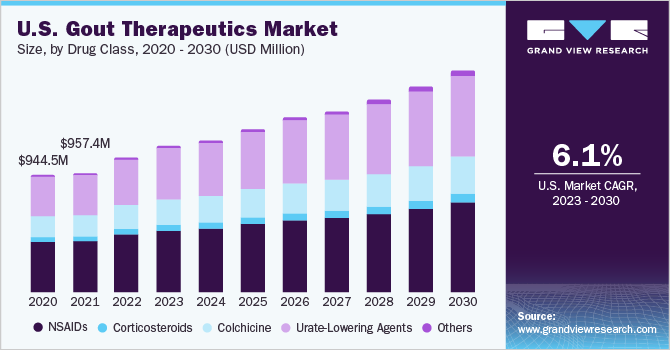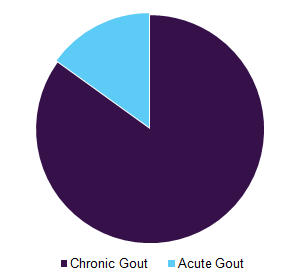
Gout Therapeutics Market Analysis By Drug Class (Nonsteroidal Anti-inflammatory Drugs [NSAIDs], Corticosteroids, Colchicine, Urate-Lowering Agents), By Disease Condition (Acute Gout, Chronic Gout), And Segment Forecasts, 2018 - 2025
- Report ID: GVR-1-68038-717-9
- Number of Pages: 100
- Format: Electronic (PDF)
- Historical Range: 2014 - 2015
- Industry:Healthcare
Industry Insights
The global gout therapeutics market size was valued at USD 1.8 billion in 2015 and is projected to grow at a CAGR of around 16 % over the forecast period. This high growth is attributed to the introduction of various drugs and increasing adoption of biologics & regenerative drugs for the treatment.
Biologics such as Krystexxa, Canakinumab, and Rilonacept have been introduced in the market. Increasing adoption of these biologics because of their ability to produce powerful anti-inflammatory action is likely to drive the market during the forecast period. Furthermore, several other drugs that are inclinical trialscurrently are expected to be launched during the forecast period, and are likely to propel the industry.
U.S. gout therapeutics market, by drug, 2014 - 2025 (USD Million)

Rising prevalence of gout across the globe due to changing lifestyle is likely to boost the industry over the coming years. Increasing alcohol consumption, high purine diet, rising obesity & kidney diseases amongst people, and consumption of certain medications such as diuretics are likely to further boost the incidence of gout.
Drug Class Insights
Nonsteroidal Anti-inflammatory Drugs (NSAIDs) dominated the industry in 2015. This is attributed to the high level of penetration of drugs, availability at lower cost in comparison to drugs of other classes, and the ability to relieve pain in case of acute gout attack.
Urate-lowering agents segment is anticipated to grow with the highest rate during the forecast period. Urate-lowering agents majorly consist of xanthine oxidase inhibitor and uricosuric agents. Growing adoption of this treatment and introduction of several drugs are likely to drive the industry during the forecast period.
Corticosteroids are generally used for patients who are intolerant to colchicine or NSAIDs. Furthermore, rebound gout attacks after the withdrawal of the steroids are common and may restrain the corticosteroids segment.
Colchicine accounted for a significant share of the industry due to the ability to inhibit acute inflammatory response by restraining neutrophil adhesion, chemotaxis, and motility. In 2009, Colcrys (colchicine) was approved by the U. S. FDA for the treatment of gout and Familial Mediterranean Fever.
Disease Condition Insights
The chronic gout segment dominated in 2015 and is expected to maintain its share during the forecast period. This segment encompasses urate-lowering agents such as xanthine oxidase inhibitor and uricosuric agents. Introduction of urate-lowering drugs and expected entry of pipeline drugs are likely to drive the market at the fastest rate during the forecast period.
NSAIDs, corticosteroids, and colchicine are majorly used to treat acute gout. Although the penetration of these drugs is higher, low cost as compared to urate-lowering agents and low treatment adherence are the key reasons for lower share in the market.
Gout therapeutics market, by disease condition, 2015

Regional Insights
North America accounted for the largest share of all the regions in 2015. This is attributed to local presence of key players, wide use of gout therapy, and high cost of branded pharmaceuticals in the U.S. The region is expected to maintain its dominance during the forecast period due to the expected launch of urate-lowering agents in the region.
亚太地区预计将遵守gr最快owth over the coming years due to rising patient pool, increasing investment by major players in the region, and rising adoption of gout therapy. Furthermore, increasing smoking prevalence & alcohol consumption and stressed lifestyle are likely to boost the incidence of gout during the forecast period.
Competitive Insights
Several regional and multinational players are operating in the market. First-line treatment for acute and chronic gout is dominated by generic drugs.
Some of the key players in the industry include GlaxoSmithKline plc; Savient Pharmaceuticals; Takeda Pharmaceutical Company Ltd.; Novartis AG; AstraZeneca plc; Merck & Co. Inc.; Teijin Pharma Ltd.; and Regeneron Pharmaceuticals.
well-establishe合作和收购d players in the market and development of innovative products are the key strategies adopted by the market players in the region. For instance, in December 2015, Horizon Pharma plc acquired Crealta Holdings LLC, with a strategic motive to expand its orphan business segment and boost rheumatology expertise & infrastructure.
In April 2016, AstraZeneca signed a licensing agreement with Ironwood Pharmaceuticals, which granted the latter exclusive rights of Zurampic (lesinurad) for the U. S. The agreement is expected to ensure successful promotion of Zurampic in the U. S.
Report Scope
Attribute |
Details |
Base year for estimation |
2016 |
Actual estimates/Historical data |
2014 - 2015 |
Forecast period |
2017 - 2025 |
Market representation |
Revenue in USD Million & CAGR from 2016 to 2025 |
Regional scope |
North America, Europe, Asia Pacific, Latin America,& MEA |
Country scope |
U.S., Canada, UK, Germany, Japan, China, Brazil, Mexico, &South Africa |
Report coverage |
Revenue forecast, company share, competitive landscape, growth factors, & trends |
15% free customization scope (equivalent to 5 analyst working days) |
If you need specific market information, which is not currently within the scope of the report, we will provide it to you as a part of customization |
Segments Covered in the Report
This report forecasts revenue growth and provides an analysis of the latest trends in each of the sub-segments from 2014 to 2025. For the purpose of this study, Grand View Research has segmented the gout therapeutics market on the basis of drug class, disease condition, and region:
Drug Class Outlook (Revenue, USD Million; 2014 - 2025)
NSAIDs
Corticosteroids
Colchicine
Urate-Lowering Agents
Disease Condition Outlook (Revenue, USD Million; 2014 - 2025)
Acute Gout
Chronic Gout
Regional Outlook (Revenue, USD Million; 2014 - 2025)
North America
The U.S.
Canada
Europe
U.K.
Germany
Asia Pacific
Japan
China
Latin America
Brazil
Mexico
MEA
South Africa




